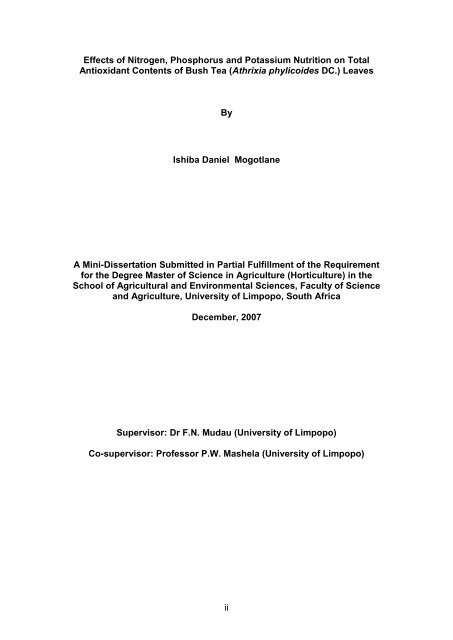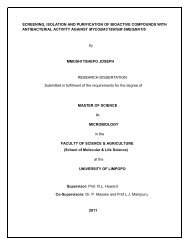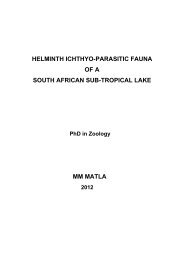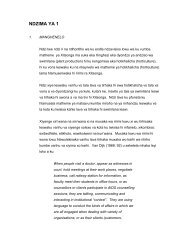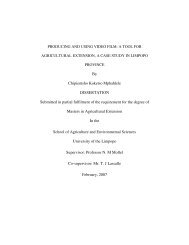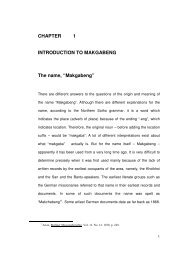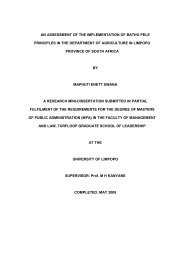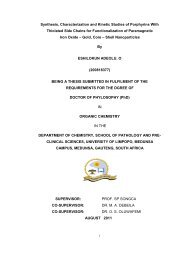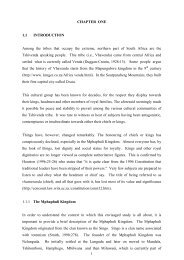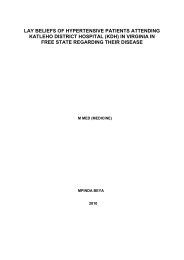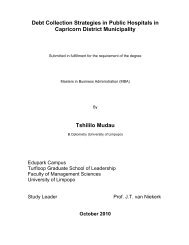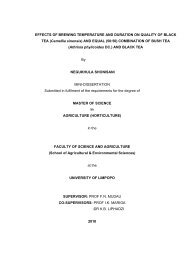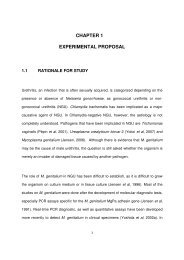Mogotlane I M.Sc front.pdf
Mogotlane I M.Sc front.pdf
Mogotlane I M.Sc front.pdf
- TAGS
- mogotlane
- ul.netd.ac.za
Create successful ePaper yourself
Turn your PDF publications into a flip-book with our unique Google optimized e-Paper software.
Effects of Nitrogen, Phosphorus and Potassium Nutrition on Total<br />
Antioxidant Contents of Bush Tea (Athrixia phylicoides DC.) Leaves<br />
By<br />
Ishiba Daniel <strong>Mogotlane</strong><br />
A Mini-Dissertation Submitted in Partial Fulfillment of the Requirement<br />
for the Degree Master of <strong>Sc</strong>ience in Agriculture (Horticulture) in the<br />
<strong>Sc</strong>hool of Agricultural and Environmental <strong>Sc</strong>iences, Faculty of <strong>Sc</strong>ience<br />
and Agriculture, University of Limpopo, South Africa<br />
December, 2007<br />
Supervisor: Dr F.N. Mudau (University of Limpopo)<br />
Co-supervisor: Professor P.W. Mashela (University of Limpopo)<br />
ii
TABLE OF CONTENTS<br />
DECLARATION iv<br />
ACKNOWLEDGEMENTS v<br />
LIST OF TABLES vi<br />
LIST OF FIGURES vii<br />
LIST OF APPENDICES viii<br />
ABSTRACT ix<br />
CHAPTER 1: INTRODUCTION<br />
CHAPTER 2: LITERATURE REVIEW<br />
iii<br />
Page<br />
2.1 Introduction 4<br />
2.2 Herbal teas 5<br />
2.3 Medicinal significance of herbal teas 7<br />
2.4 Antioxidants 8<br />
2.5 Natural vs. synthetic antioxidants 9<br />
2.5.1 Dangers of synthetic antioxidants 11<br />
2.5.2 Natural vs. synthetic vitamin E 11<br />
2.6 Solubility of Antioxidants 13<br />
2.7 Antioxidant activities of polyphenols 14<br />
2.8 Factors affecting antioxidant activities 17<br />
2.8.1 Structures of antioxidants 17<br />
2.8.2 Processing 19<br />
2.8.3 Synergy 20<br />
2.9 Measurements of total antioxidant activities 21<br />
2.9.1 DPPH antiradical method 21<br />
2.9.2 ABTS antiradical method 24<br />
2.10 Antioxidant efficiency 25<br />
2.11 Summary and conclusions 26<br />
1
CHAPTER 3: RESPONSE OF TOTAL ANTIOXIDANT CONTENT IN BUSH<br />
TEA (ATHRIXIA PHYLICOIDES DC) TO NITROGEN,<br />
PHOSPHORUS AND POTASSIUM NUTRITION AS<br />
AFFECTED BY SEASON<br />
3.1 Introduction 28<br />
3.2 Materials and methods 29<br />
3.2.1 Preparation of leaf extracts for total antioxidant content 29<br />
3.2.2 Determination of total antioxidant content 29<br />
3.2.3 Statistical Analysis 30<br />
3.3 Results and discussion 30<br />
3.3.1 Nitrogen experiments 30<br />
3.3.2 Phosphorus experiments 31<br />
3.3.3 Potassium experiments 32<br />
CHAPTER 4: SUMMARY AND CONCLUSIONS 35<br />
REFERENCES 37<br />
APPENDICES 54<br />
iv
DECLARATION<br />
I hereby declare without reservation that the data recorded herein were<br />
originated and compiled by myself and that the data have never been<br />
published at the University of Limpopo or elsewhere. Work by other authors<br />
that formed part of literature review has been duly acknowledged by the<br />
citation and reference list of authors.<br />
_____________________ _______________<br />
Student: I.D. <strong>Mogotlane</strong> Date<br />
______________________ _______________<br />
Supervisor: Dr F.N. Mudau Date<br />
________________________________ _______________<br />
Co-Supervisor: Professor: P.W. Mashela Date<br />
v
ACKNOWLEDGEMENTS<br />
I would like to acknowledge the following people who contributed significantly<br />
to the success of this project: First and foremost my supervisors, Dr. F.N.<br />
Mudau and Professor P.W. Mashela for their critical comments, indepth<br />
support and advice throughout the implementation of the study. My gratitude<br />
is also extended to Morgenzon, a commercial nursery, for providing the trial<br />
sites, Jumbo Makgalefe and the Department of Biochemistry, University of<br />
Limpopo for technical assistance during total antioxidant activities analysis,<br />
the National Research Foundation (NRF) and Agricultural Research Council<br />
(ARC-LNR) for financial assistance. My sincere thanks to my lovely parents,<br />
Frans & Francina,; brothers and sisters and most importantly my precious<br />
wife, Stella and sons, Motlotswa Daniel Jnr and Mogau Shekinah for their<br />
support and encouragement during this project. Finally, over and above all I<br />
would like to thank Jehovah Elshadai for the strength, the wisdom and the<br />
protection He provided me at all times.<br />
vi
Table<br />
3.1<br />
Table<br />
3.2<br />
Table<br />
3.3<br />
LIST OF TABLES<br />
Response of TAC of cultivated bush tea to N nutrition as<br />
affected by seasons<br />
Response of TAC of cultivated bush tea to P nutrition as<br />
affected by seasons<br />
Response of TAC of cultivated bush tea to K nutrition as<br />
affected by seasons<br />
vii<br />
Page<br />
31<br />
32<br />
33
LIST OF FIGURES<br />
viii<br />
Page<br />
Figure 2.1 Bush tea (Athrixia phyliocoides DC.) in flower (Van Wyk<br />
& Gericke, 2000)<br />
Figure 2.2 Structure showing how antioxidants scavenge free<br />
radicals (Richards, 2004)<br />
6<br />
9
LIST OF APPENDICES<br />
Appendix1 Analysis of variance for N nutrition on seasonal variation of<br />
total antioxidant contents (TAC) in bush tea<br />
Appendix2 Analysis of variance for P nutrition on seasonal variation of<br />
total antioxidant contents (TAC) in bush tea<br />
Appendix3 Analysis of variance for K nutrition on seasonal variation of<br />
total antioxidant contents (TAC) in bush tea<br />
ix<br />
Page<br />
54<br />
55<br />
56
ABSTRACT<br />
Bush tea (Athrixia phylicoides DC) has been used for many years by the<br />
people of South Africa for medicinal purposes. The herbs was only harvested<br />
from the wild, therefore data on the effects of mineral nutrition on total<br />
antioxidant activity had not been established. The objective of this study was<br />
to determine the seasonal effect of nitrogen (N), phosphorus (P) and<br />
potassium (K) nutrition on total antioxidant activity (TAA) in cultivated bush tea<br />
leaves. Treatments consisted of 0, 100, 200, 300, 400 or 500 kg�ha -1 N, P or<br />
K in a randomized complete block design with four replications under 50 %<br />
shade nets. Three (N, P and K) parallel trials were conducted per season<br />
(autumn, winter, spring and summer). TAA was determined using 2,2-<br />
diphenyl-1-picrylhydrazyl-hydrate (DPPH) method and analyzed in a<br />
spectrophotometer. Results of this study demonstrated that regardless of<br />
season, the application of N, P and K fertilizers increased quadratically levels<br />
of TAA in bush tea with most of the increase occurring between 0 and 300 N,<br />
300 P and 200 K kg�ha -1 . Therefore, for improved total antioxidant content in<br />
bush tea leaves, 300 N, 300 P and 200 K kg�ha -1 N are recommended.<br />
x


